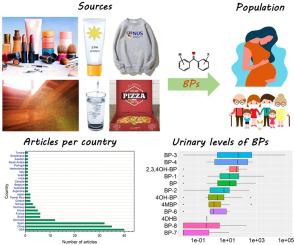Environment International ( IF 10.3 ) Pub Date : 2022-07-11 , DOI: 10.1016/j.envint.2022.107405 Jason Feijian Mao 1 , Wenxuan Li 2 , Choon Nam Ong 3 , Yiliang He 4 , Mui-Choo Jong 5 , Karina Yew-Hoong Gin 6

|
To avoid the harmful effects of UV radiation, benzophenone-type UV filters (BPs) are widely used in personal care products and other synthetic products. Biomonitoring studies have shown the presence of BPs in various human biological samples, raising health concerns. However, there is a paucity of data on the global human exposure to this group of contaminants. In this study, we compiled data on the body burden of BPs along with the possible exposure routes and biotransformation pathways. BPs can easily penetrate the skin barrier and thus, they can be absorbed through the skin. In the human body, BPs can undergo Phase I (mainly demethylation and hydroxylation) and Phase II (mainly glucuronidation and sulfation) biotransformations. From a total of 158 studies, most of the studies are related to urine (concentration up to 92.7 mg L–1), followed by those reported in blood (up to 0.9 mg L–1) and milk (up to 0.8 mg L–1). Among BPs, benzophenone-1 and benzophenone-3 are the most commonly detected congeners. The body burden of BPs is associated with various factors, including the country of residence, lifestyle, income, education level, and ethnicity. The presence of BPs in maternal urine (up to 1.1 mg L–1), placenta (up to 9.8 ng g−1), and amniotic fluid (up to 15.7 μg L–1) suggests potential risks of prenatal exposure. In addition, transplacental transfer of BPs is possible, as demonstrated by their presence in maternal serum and cord serum. The possible association of BPs exposure and health effects was discussed. Future human biomonitoring studies and studies on the potential health effects are warranted. Overall, this review provides a summary of the global human exposure to BPs and can serve as supporting evidence to guide usage in order to protect humans from being exposed to BPs.
中文翻译:

人体暴露于二苯甲酮类紫外线过滤剂的评估:综述
为避免紫外线辐射的有害影响,二苯甲酮类紫外线过滤剂 (BP) 广泛用于个人护理产品和其他合成产品中。生物监测研究表明,各种人类生物样本中都存在 BP,这引发了人们对健康的担忧。然而,关于全球人类暴露于这组污染物的数据很少。在这项研究中,我们汇总了 BP 的身体负担数据以及可能的暴露途径和生物转化途径。BPs 可以很容易地穿透皮肤屏障,因此可以通过皮肤吸收。在人体内,BPs可发生I期(主要是去甲基化和羟基化)和II期(主要是葡萄糖醛酸化和硫酸化)生物转化。在总共 158 项研究中,大多数研究与尿液有关(浓度高达 92.7 mg·L–1 ),其次是血液中报道的含量(最高 0.9 mg L -1)和牛奶(最高 0.8 mg L -1)。在 BP 中,二苯甲酮 1 和二苯甲酮 3 是最常检测到的同源物。BP的身体负担与居住国、生活方式、收入、教育水平和种族等多种因素有关。母体尿液(高达 1.1 mg L -1)、胎盘(高达 9.8 ng g -1)和羊水(高达 15.7 μg L -1 )中存在 BP) 表明存在产前暴露的潜在风险。此外,BPs 的经胎盘转移是可能的,正如它们在母体血清和脐带血清中的存在所证明的那样。讨论了 BPs 暴露和健康影响的可能关联。未来的人类生物监测研究和对潜在健康影响的研究是必要的。总体而言,本综述总结了全球人类对 BPs 的暴露情况,并可作为指导使用的支持证据,以保护人类免受 BPs 的暴露。











































 京公网安备 11010802027423号
京公网安备 11010802027423号